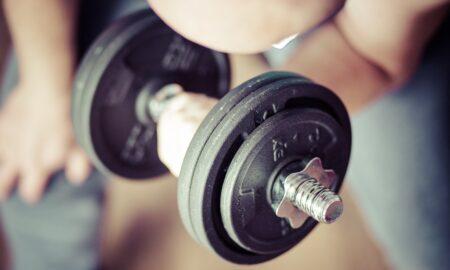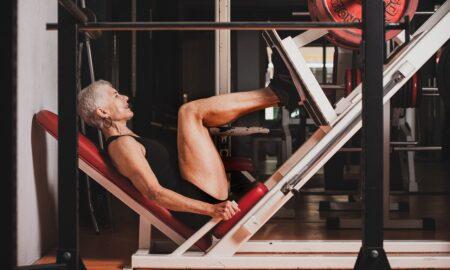

Do you want to have a perfect physique like track star Hussein Bolt? Do you want to run at least two or more daily and build speed, agility, muscle mass, and cardiovascular fitness? If yes, then you are at the right place.
Track training is one of the best ways to get into shape and implement your training plans. It’s also one of the most strenuous forms of exercise. It involves much more than just running (although running is critical).
To be successful with track training, you need to focus on building lean muscle mass, increasing your strength and endurance, and burning fat. You also need to work out your diet to meet your body’s needs to reach your goal.
Here’s the secret track athlete workouts and diet to a lean, toned, muscular body you crave. The activities will also increase your competitive edge in marathons, sprints, and distance races.
Cardio Workouts for Track Stars
Cardio workouts are a significant factor in achieving success as a track star. This is because they are the most efficient way of training for endurance and speed. The key to getting the most out of your cardio workouts is ensuring you do them correctly.
There are many types of cardio workouts for a track star. It depends on fitness level and goals. Track sport requires a lot of stamina and endurance, so a track star’s cardio workouts should be intense and challenging. It may be best to do high-intensity interval training (HIIT) and other intense workouts with a treadmill or elliptical machine.
You can also train your body by doing various cardio workouts focusing on different muscle groups. The exercises are:
Running
Running is one of the most popular form of cardio workout because it is low-impact, and you can do it anywhere without equipment. It also doesn’t require much time or money to start running, making it very accessible to people who want to get into shape but don’t have much time on their hands or money.
The running workout is an excellent exercise for building endurance and speed. It also helps to improve muscle strength. But that’s not all! There are also many physical and mental health benefits from running that make it well worth the effort. They include:
- Running burns calories and helps you lose weight.
- It improves cardiovascular fitness by strengthening your heart and lungs and increasing blood flow throughout your body.
- Regular running builds a protective framework around the skeleton, which makes muscles and bones more resistant to fractures due to falls or trauma.
- Running builds strength in your legs, which will help you improve your running speed.
- Running Increases Endurance. It helps the body develop stronger muscles and increase stamina to last long periods without getting tired.
- Reduces Stress -running releases endorphins, natural pain killers that make you feel good and reduce stress.
Short Interval Training
Short interval training increases stamina by increasing the intensity of your regular workouts and alternating between lower and higher heart rate zones for 30 minutes. You can start at 250 meters and work your way down to 50 meters if you are an advanced track star. For beginners, start at 50 metres while alternating between running/ jogging and walking.
Jump Rope Training

It is a great way to improve your agility and footwork. It trains your legs and feet to spend less time on the ground, improving speed and stamina.
Rowing
If you want to build up your endurance, consider doing rowing intervals where you row hard for 20 seconds, then rest for 60 seconds before continuing with another 20-second set. You can do this on a machine if your gym doesn’t have a rowing machine available or with body weight resistance if you find something that works well for this type of workout (like skipping rope).
Stair Exercise
A stair climbing workout increases your cardiovascular endurance while increasing muscle strength and flexibility and reducing the risk of injuries. Stair workouts are also a great option because you can do them anywhere, so long as you have access to stairs.
The key to stair climbing is walking and not jogging. Jogging will cause you to lose balance and even make you dizzy if you do too much in one session. If you are new to this type of workout, start with just one flight of stairs at a time.
Power and Endurance Workouts
Endurance training helps build stamina to run for extended periods without getting winded or hurting yourself from overworking your muscles. Power training helps build muscle in your arms and legs. This increases your speed because you can push off the ground with more force since you have strength.
The following workout will work on the power and endurance of the body while also working on speed and agility. While doing these exercises, ensure your rest days are included between each session.
1. Overhead Squat
The overhead squat is a weightlifting exercise used to train the muscles of the upper body, core, and lower body efficiently, which is an integral part of any track athlete’s training routine. It mimics the motion of a person squatting down to lift an object off of the ground.
To do an overhead squat, stand with your feet shoulder-width apart and your toes pointed outwards. Hold a barbell or dumbbell over your head with both hands facing up. While keeping your back straight, bend at the hips and knees until you are in a squat position (keeping your heels on the ground).
Push your hips back as you descend into the squat position and keep them there throughout the movement. Once in place, push back up to an upright standing position while squeezing your glutes tightly together.
2. Single Leg Romanian Dead Lift
The Single Leg Dead Lift is a unilateral variation of deadlift exercise that works on the glutes and hamstrings to increase muscular strength and endurance. You can do it with a barbell, kettlebell, or dumbbell.
To perform this exercise, stand on your two feet about shoulder-width apart with a dumbbell in your hand. Raise one of your feet off the ground and bend it at the knee, creating balance on your foot on the floor. Ensure your ribs are down and your pelvis facing forward.
Slowly push your hips back, reaching the glutes while lowering your torso forward and down till it’s parallel with the floor.
Come under control by exhaling with a tense breath and bring your right foot to the ground as you extend your hips to a standing position once you feel a stretch in your hips. Perform 10 reps of 2-3 sets before switching on the left leg.
3. Overhead Lunge
Overhead lunge, also known as walking or weighted overhead, is an excellent exercise for your hip flexors and quadriceps. It also strengthens your core, glutes, and hamstrings.
Overhead lunge exercise builds lower and upper body strength and improves body balance and core stability. In addition, it increases your leg propulsion and core strength making it a great way to challenge your balance as you shift your focus from one leg to the next, similar to when you’re running.
To do the exercise, start with your feet placed about shoulder width apart and your knees bent. Lift the weight above your head, ensuring it is directly over your head and centered between shoulder joints.
Exhale while you take a significant step forward with your right foot and slowly lower your body into a lunge position. Ensure your abs are tight and chest up. Inhale and pause.
Push off with the front foot and bring it back up to starting position while stepping forward with the other foot. Perform 15 reps of 3 sets before switching sides and repeat the same number of reps with your other leg.
4. Burpees
A burpee is a full-body exercise consisting of a squat, a push-up, and jumping up to return to standing. It aims at muscle strengthening and cardiovascular endurance in your upper and lower body by using your body weight for resistance.
To perform the exercise, start in a squat position with your feet shoulder-width apart and your back straight. Lower your hands on the floor directly before you, just inside your feet.
Moves your feet back to be on your toes and hands. Then push yourself up into an upright position while extending your arms overhead. Jump high before returning to the squat position with your hand on the ground. Do 20 reps of 2-3 sets.
Sprinting Workouts

Sprinting workouts are incredibly effective at improving your overall physical fitness level. By incorporating sprints into your fitness routine, you can improve your cardiovascular fitness, increase your speed and power, and become more efficient in all areas of your running, increasing cardiovascular and muscular endurance.
You can do Sprinting workouts in various ways, but common variations include short bursts of high-intensity cardio or interval training. They are typically broken down into sets of 30 seconds, with a 1-2-minute break between each set.
This type of workout will work your entire body, from your arms and legs to your core and heart. Here are some tips on how to do it right:
- Start slow and build up speed over time.
- Warm up your muscles by running in place or doing some light jumping jacks or toe touches while you walk around the block or run in place at a low intensity for 10 minutes.
- Take some time to allow your muscles to recover.
Workout 1- 10 x 200
If you’re new to sprinting workouts, start with this workout.
Warm up for five minutes by doing exercises such as walking, jogging, or dynamic training. Sprint for 30 seconds at a moderate speed of about 50-60 % of your max strength and then rest by slowing your speed or walking for 60-120 seconds before doing another 30 seconds at your max speed of 70%.
Actively recover by slowing down your speed for 120 seconds before sprinting for another 30 seconds at your maximum effort of 80%. Rest for 120 seconds and continue with the pattern for 20 minutes at 80% maximum effort
Workout 2 Advanced Sprint Workout
Once you’ve mastered the beginner’s workout, you may take it to the next level by increasing the intensity reducing the recuperation interval and changing the sprint duration.
For instance, you can alter the part of sprinting for 30 seconds at a maximum effort of 80% and recovery duration of 120 seconds to 45 seconds of running at 80% of your max effort and 120-second recovery period or reduce the recovery time only from 120 to 60 seconds.
- Warm Up 5 minutes
- Sprint for 30 seconds at your maximum effort of 80% active recovery time of 60 seconds or sprint at 95% effort (as fast as you can go) at 1% incline with a 90-sec recovery walk or jog for 12 sec.
- Repeat the pattern 30 times
Workout 3 Hill Sprint Workout
The hill sprint workout is a great way to burn fat and build muscle while you push your limits. With interval training, you can do it on a treadmill or a steep hill.
The intervals will vary depending on the terrain, but they will always be high-intensity bursts of activity followed by rest periods. Maintain a consistent effort on the way up and use the downhills as your recovery when doing the exercise.
- Sprint ⅓ of the hill at a maximum pace, then jog down at a low pace
- Sprint ⅔ of the hill at a maximum speed, then jog down at the low pace
- Run up the hill at your maximum rate, then jog down at an easy pace. Recover for 2 min.
- 4 x 20 sec. Run up the hill, followed by a slow jog down
Endurance Sprint Workout
The goal of an endurance sprint workout is to maintain your top speed for a more extended period. It trains your body to be at ease, maintaining a quicker pace for extended periods, which is crucial for people competing in a half-marathon or marathon.
- Sprint for 4 x 18 for 22 sec at 85% maximum effort at an 8% incline and
90-sec recovery walk or jog - Sprint for 4 x 18for 22 sec at 95% max effort at a 1% incline and 90-sec recovery walk or jog
Pyramid Style Sprint Workout
Pyramid-style sprint exercises increase your speed before bringing you back to the beginning. They’re perfect for keeping your body guessing. Additionally, because recoveries last twice as long as work efforts, you’re constantly feeling prepared for the next interval.
- Sprint for 30sec and then take 1 min for active recovery by walking or jog
- sprint for 45sec followed by 90-sec of active recovery
- Sprint for 1 min, recover for 2 min by walking or jogging
Repeat four times
Diet for a Track Star
Track stars rely on dietician guidelines to help them get the required calories for optimum energy output to carry out their workouts. For track stars to run 100 or 200 meters, they need a high carbohydrate meal and enough glycogen in their body. They also need proteins and healthy fats though they are not broken down as fast as carbohydrates during the workout.
Nevertheless, track stars still get most of their food from protein distributed as 60% protein, 30% carbs, and 10% fat, while sprinters only need 1 gram of protein per body weight to build and maintain muscles.
Although supplements are not required, dieticians recommend supplements like Creatine and glutamine.
When the two supplements are combined, they provide an additional boost for pre- and post-workouts. Creatine replenishes energy stores depleted by training, whereas glutamine boosts the immune system, develops muscle, and promotes rapid recovery after a hard workout.
Conclusion
Track star workouts and diet plans effectively improve your overall fitness level. By incorporating the exercises into your fitness routine, you can improve your cardiovascular health and fitness, increase your speed and power, and become more efficient in all areas of your running.
Start the workouts today to increase your running speed, strength, and endurance!





















You must be logged in to post a comment Login